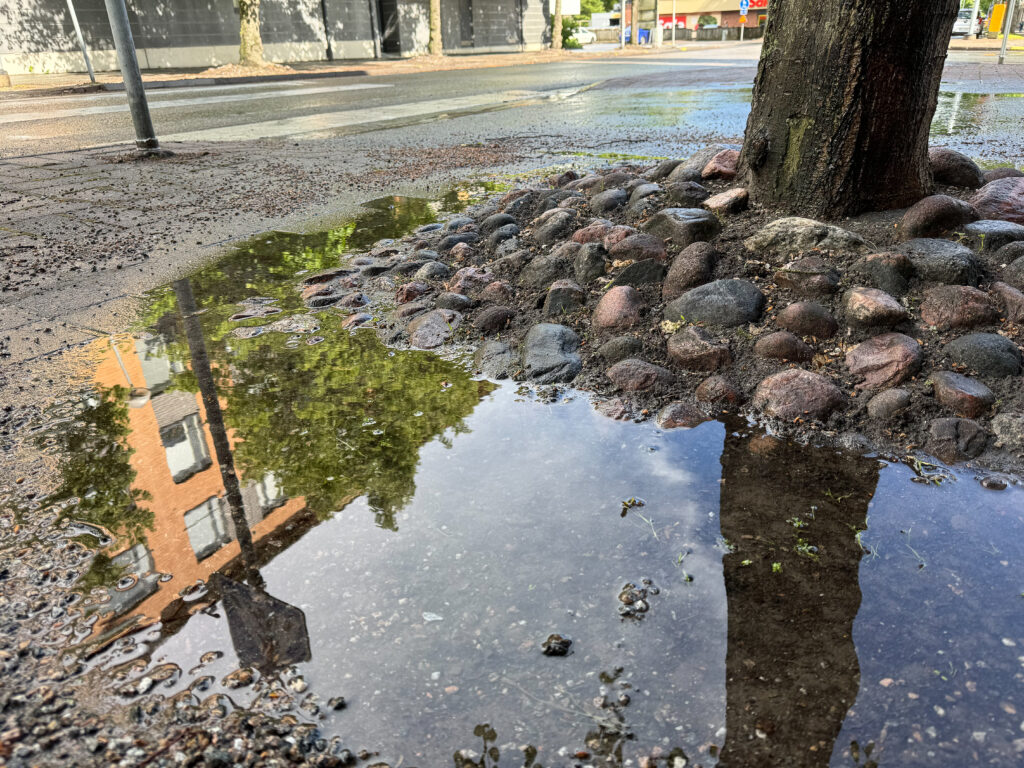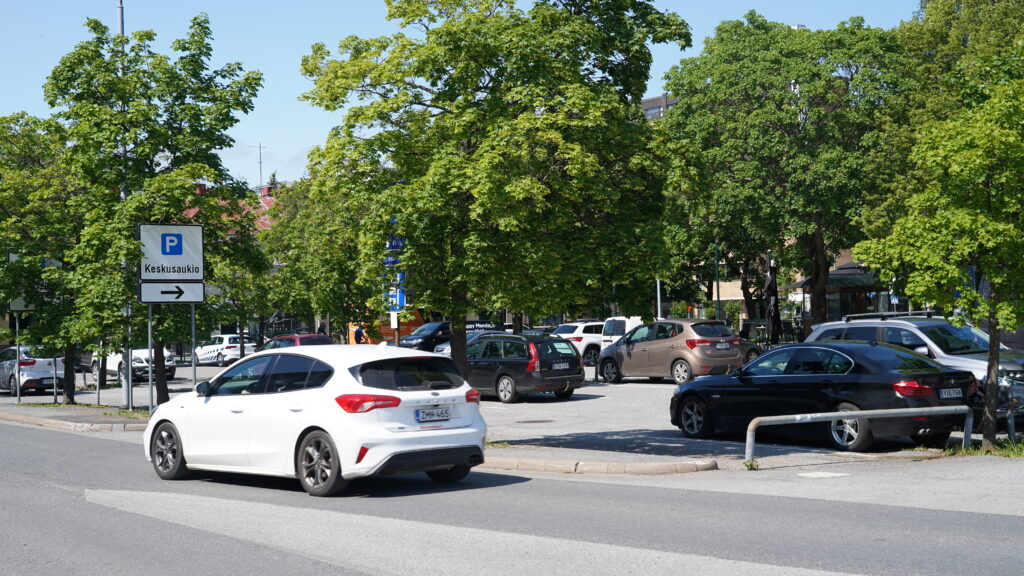Why MUSTBE Is a “Must Be”?
Extreme weather conditions. Urbanisation and increased building density. These factors – and some more – together have laid the foundation why the seven partners in four Central Baltic countries joined their forces to develop multidimensional and nature-based stormwater management solutions.

Photo: Hanna Kajander
Urbanisation and increasing residential density are the main points in the origin of problematic stormwater formation. Surface runoff is formed when water from rainfalls or snowmelts is not capable of infiltrating into the soil because it lands on impermeable surface. As the amount of water accumulates on the impermeable surface, such as asphalt or concrete, the water will eventually begin to flow on the surface. The flow tends to pick up solids and substances, and some of them are harmful for the surrounding environment. Then again, the water landing on permeable surface, such as lawn or forest bed, will soak into the soil through infiltration thus reducing the stress on stormwater systems especially during extreme weather conditions.
There are two major problems to which insufficient urban stormwater management can lead: incontrollable flooding during heavy rainfalls, and the harmful substances carried by stormwater flowing into waterbodies, harming the water quality and thus aquatic ecosystems. Although countries in the Baltic Sea region have taken actions on the matter, pollutants and hazardous substances are still released into the sea through urban stormwater systems. MUSTBE, a cross-border project in the Baltic Sea region, has started to develop solutions for tackling the problem – and moving towards a greener future for the sea with less stormwater related pollution.
Sevent Pilot Sites in Four Countries
There are seven MUSTBE pilot sites in Sweden, Finland, Estonia and Latvia. Each pilot site has its own characteristics and challenges, and while there are similarities in some aspects they do have different needs for stormwater management solutions.
The two pilot sites of the City of Pori, Finland, represent these differences perfectly. One of the pilot sites – located in the center of the city – has a high flooding risk: Finland’s presumably most severe city flood ever occurred in Pori in 2007. The nature-based solution (later in the text: NBS) developed for the area focuses primarily on managing stormwater through qualitative and quantitative approach. Pori’s other pilot site, a wetland in a residential area, has not had issues with flooding. Instead, the improved stormwater treatment in the area focuses on nature-based water purification. This is because the runoff of the wetland is acidic and the ditch in the wetland is connected to a river which eventually flows into the Baltic Sea. Therefore, the main point of the developed NBS at the wetland is to prevent harmful substances from entering the sea.

Photo: Krista Valkonen
The Most Polluted Sea in the World Needs Protection
According to the John Nurminen Foundation, the Baltic Sea is one of the most polluted seas in the world. The sea is threatened by overfishing, oil transport, increasing shipping traffic and climate change, but mostly due to eutrophication: the small sea suffers from nutrient pollution (The John Nurminen Foundation)
While urban runoff and harmful substances of stormwater may not be the main root cause of eutrophication, every action for improved stormwater quality counts. And, even if stormwater problems originate from human actions, climate change, and urbanisation, the positive thing is that they can also be tackled by human actions.
One great example of how good decisions do make a difference, is the decrease in lead occurrence in the environment. In the 20th century, lead was still commonly used, and the occurrences were significantly higher than nowadays. As its usage in motor vehicle gasolines was widely prohibited by 1990’s, the amount began to decrease drastically. Despite the positive progress, lead is still considered as one of the harmful heavy metals that can be found in polluted stormwater. This is because its persistence, and some of the lead circulating in the environment nowadays was in fact released many years ago (United States Environmental Protection Agency; Kasurinen).
The Many Benefits of MUSTBE Solutions
Before inflowing to waterbodies, purification of stormwater near its place of origin is usually preferred. In urban areas, directing them to wastewater treatment plants can significantly burden the purification processes of wastewater, leading to a need for bigger capacity and increase in energy consumption. Instead, NBS can offer a more cost-efficient and energy saving option.
Furthermore, MUSTBE develops multi-objective stormwater management solutions that bring added value to the urban environment. Not only the primary problem is solved and nutrients released into the Baltic Sea is less, but solutions have co-benefits such as increase in greenery and landscape quality, reduction of noise, mitigation of impacts of heat waves, improved air quality – and so on. All of these contribute to the well-being of people and the environment.
That’s why MUSTBE is a “mustbe”.
Common Substances Polluting Water
| Name and type | Why is it considered harmful? | Typical sources |
| Nitrogen and Phosphorus, nutrients | Not harmful substances per se. In adequate amounts, both are beneficial for the aquatic biosphere. Too high levels of nutrients cause eutrophication. [2, 3, 4, 5] | Fertilisers (in urban areas used in green areas), sewers, animal faeces and traffic. [1, 3, 4] |
| Microbial contaminants, pathogens | Infection and disease risks. | In many cases, animal or human faecal contamination and sewer overflows. [4, 5] |
| Mercury, Lead and Cadmium, heavy metals not necessary for living organisms | Poisonous metals that accumulate in food chains may cause problems with metabolism and health. Even low concentration may cause harm. [2, 3, 5] For example, high concentrations of mercury have been found in predator fish. [5] | Fuels, raw materials, traffic and air sources originating from industry. Some of the mercury and lead circulating through today’s environment was released years ago. [3, 4, 5] |
| Copper, Nickel, Zinc and Chrome, heavy metals necessary for living organisms | Not harmful per se, but high concentrations cause harm for plants and animals. Unlike naturally occurring chrome, industrially used chrome is considered harmful because of its different oxidation number. [3, 5, 6] | Traffic, industrial waste materials and buildings, especially galvanised metal surfaces such as roof tops and downspouts. [2, 3, 4, 5] |
| Pesticides and herbicides | Toxicity risks for living organisms [7] | In urban areas, gardens, lawn areas and roadsides. [3, 4, 5, 7] |
Sources
- Materials and resources of the MUSTBE project
- [1] The John Nurminen Foundation: Baltic Sea Facts (2004): https://johnnurmisensaatio.fi/en/baltic-sea/baltic-sea-information/
- [2]: United States Environmental Protection Agency. (19.8.2024). Clean Water Act Section 303(d): Impaired Waters and Total Maximum Daily Loads (TMDLs): https://www.epa.gov/tmdl
- [3]: Kasurinen, Eetu: Hulevesien haitta-aineet ja käsittelymenetelmät (2020) [Bachelor of Science Thesis, Tampere University] Trepo-julkaisuarkisto: chrome-extension://efaidnbmnnnibpcajpcglclefindmkaj/https://trepo.tuni.fi/bitstream/handle/10024/122880/KasurinenEetu.pdf?sequence=2&isAllowed=y
- [4] Suomen Ympäristökeskus. (1.2.2022). Hulevesien ympäristöriskit: https://www.vesi.fi/vesitieto/hulevesien-ymparistoriskit/
- [5] Stormwater solutions (2024): https://www.stormwater.com/
- [6] Pooja Sharma, Surendra Pratap Singh, Sheetal Kishor Parakh, and Yen Wah Tong (2022): Health hazards of hexavalent chromium (Cr (VI)) and its microbial reduction. Bioengineered: https://www.ncbi.nlm.nih.gov/pmc/articles/PMC8973695/
- [7] A review on microbial contaminants in stormwater runoff and outfalls: Potential health risks and mitigation strategies: https://www.ncbi.nlm.nih.gov/pmc/articles/PMC7126443/
Writers and editors: Krista Valkonen, Hanna Kajander and Meri-Maaria Salo

